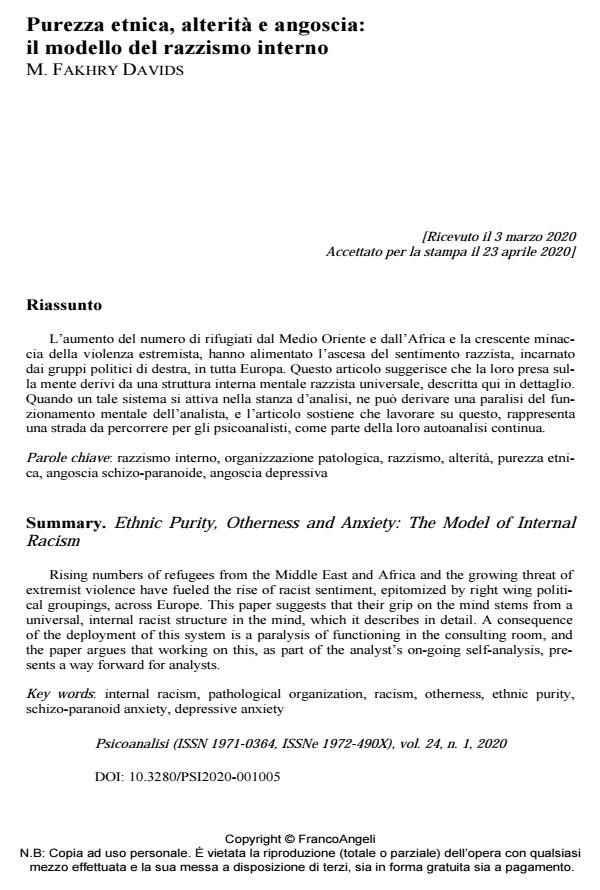Purezza etnica, alterità e angoscia: il modello del razzismo interno
Titolo Rivista PSICOANALISI
Autori/Curatori M. Fakhry Davids
Anno di pubblicazione 2020 Fascicolo 2020/1
Lingua Italiano Numero pagine 24 P. 63-86 Dimensione file 251 KB
DOI 10.3280/PSI2020-001005
Il DOI è il codice a barre della proprietà intellettuale: per saperne di più
clicca qui
Qui sotto puoi vedere in anteprima la prima pagina di questo articolo.
Se questo articolo ti interessa, lo puoi acquistare (e scaricare in formato pdf) seguendo le facili indicazioni per acquistare il download credit. Acquista Download Credits per scaricare questo Articolo in formato PDF

FrancoAngeli è membro della Publishers International Linking Association, Inc (PILA)associazione indipendente e non profit per facilitare (attraverso i servizi tecnologici implementati da CrossRef.org) l’accesso degli studiosi ai contenuti digitali nelle pubblicazioni professionali e scientifiche
L’aumento del numero di rifugiati dal Medio Oriente e dall’Africa e la crescente minaccia della violenza estremista, hanno alimentato l’ascesa del sentimento razzista, incarnato dai grup-pi politici di destra, in tutta Europa. Questo articolo suggerisce che la loro presa sulla mente derivi da una struttura interna mentale razzista universale, descritta qui in dettaglio. Quando un tale sistema si attiva nella stanza d’analisi, ne può derivare una paralisi del funzionamento men-tale dell’analista, e l’articolo sostiene che lavorare su questo, rappresenta una strada da percor-rere per gli psicoanalisti, come parte della loro autoanalisi continua.
Parole chiave:Razzismo interno, organizzazione patologica, razzismo, alterità, purezza etnica, angoscia schizo-paranoide, angoscia depressiva
- Dalal F. (2002). Race, Colour and the Processes of Racialization: New Perspectives from Psychoanalysis, Group Analysis and Sociology. Hove & New York: Brunner-Routledge.
- Davids M.F. (1995). The management of projective identification in the treatment of a borderline psychotic patient. In: Ellwood J. (ed.). Psychosis: Understanding and Treatment (pp. 162-180). London: Jessica Kingsley.
- Davids M.F. (2002). September 11th 2001: Some thoughts on racism and religious prejudice as an obstacle. British Journal of Psychotherapy, 18, 3: 361-366.
- Davids M.F. (2006). Internal racism, anxiety and the world outside: Islamophobia post-9/11. Organisational & Social Dynamics, 6, 1: 63-85.
- Davids M.F. (2011). Internal Racism: A Psychoanalytic Approach to Race and Difference. Houndmills, Basingstoke: Palgrave Macmillan.
- Freud S. (1900). The Interpretation of Dreams. In: Strachey J. (ed.). The Standard Edition of the Complete Psychological Works of Sigmund Freud, Volume: IV. London: Hogarth Press & Institute of Psychoanalysis.
- Hamer F.H. (2002). Guards at the gate: race, resistance and psychic reality. Journal of the American Psychoanalytic Association, 50: 1219-1237.
- Kareem J. (1988). Outside in... inside out... Some considerations in inter-cultural psychotherapy. Journal of Social Work Practice, 3, 3: 57-71.
- Kareem J. (1992). The Nafsiyat Intercultural Therapy Centre: Ideas and experience in intercultural therapy. In: Kareem J., Littlewood R. (eds.). Intercultural Therapy: Themes, Interpretations and Practice. Oxford: Blackwell Scientific Publications.
- Leary K. (2000). Racial enactments in dynamic treatment. Psychoanalytic Dialogues, 10: 639-653 DOI: 10.1080/10481881009348573
- Macpherson, W. (1999). A Summary of The Stephen Lawrence Inquiry: Report of an Inquiry by Sir William Macpherson of Cluny. Norwich: HMSO. Retrieved from http://www.law.cf.ac.uk/tlru/Lawrence.pdf
- Moss D. (2001). On Hating in the First Person Plural: Thinking Psychoanalytically about Racism, Homophobia and Misogyny. Journal of the American Psychoanalytic Association, 49, 4: 1315-1334. DOI: 10.1177/00030651010490041801
- Norton-Taylor R. (1999). The Colour of Justice. London: Oberon Books.
- Perez Foster R.M. (1996). What is a multicultural perspective for psychoanalysis? In: Perez Foster R., Moskowitz M., Javier R.A. (eds.). Reaching across Boundaries of Culture and Class: Widening the Scope of Psychotherapy (pp. 3-20). North Vale, New Jersey and London: Jason Aronson.
- Perez Foster R.M., Moskowitz M., Javier R.A. (1996). Reaching Across Boundaries of Culture and Class: Widening the Scope of Psychotherapy. North Vale, New Jersey and London: Jason Aronson.
- Roland A. (1996). Cultural Pluralism & Psychoanalysis: The Asian and North American Experience. New York & London: Routledge.
- Rustin M. (1991). Psychoanalysis, racism and anti-racism. In: The Good Society and the Inner World. London: Verso.
- Sachs W. (1937). Black Hamlet (with new introductions by Saul Dubow and Jacqueline Rose). Johannesburg/Baltimore: Witwatersrand University Press/Johns Hopkins University Press, 1996.
- Sandler J., Sandler A.M. (1987). The past unconscious, the present unconscious and the vicissitudes of guilt. International Journal of Psycho-anal., 68: 331-341.
- Schachter J.S., Butts H.F. (1968). Transference and countertransference in interracial analyses. Journal of the American Psychoanalytic Association, 16: 792-808.
- Steiner J. (1987). The interplay between pathological organisations and the paranoid-schizoid and depressive positions. International Journal of Psycho-anal., 68: 69-80.
- Steiner J. (1993). Psychic Retreats: Pathological Organisations in Psychotic, Neurotic and Borderline Patients. In: Spillius E.B. (ed.). New Library of Psychoanalysis (vol. 19). London & New York: Routledge.
- Thomas L. (1992). Racism and psychotherapy: Working with racism in the consulting room - an analytical view. In: Kareem J., Littlewood R. (eds.). Intercultural Therapy: Themes, Interpretations and Practice. Oxford: Blackwell Scientific Publications.
M. Fakhry Davids, Purezza etnica, alterità e angoscia: il modello del razzismo interno in "PSICOANALISI" 1/2020, pp 63-86, DOI: 10.3280/PSI2020-001005